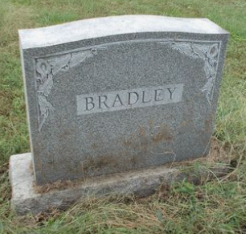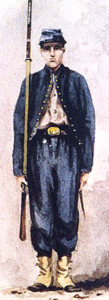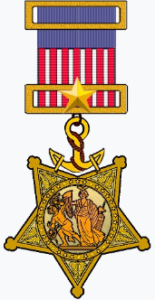Title: Army Sergeant, Civil War; Marine Corps Sergeant, Medal of Honor
Birthdate: July 14, 1838
Death Date: January 1, 1884
Plot Location: Section 104, Lot 24, two from SW corner

The Bradleys arrived from Ireland long before there was a food shortage in that country. John was born in Philadelphia after his parents settled here. He was named after his father and was much older than his two younger brothers: Tom was born in 1849 and George in 1851. The last child born was Fanny, born in April of 1854. Her father died that August and then she died the following July.
John was 16 when his brothers were still preschoolers. Fortunately there were other relatives living in the home; his mother’s father was a lawyer, and his father’s sister was a dressmaker. The 1860 census listed John as a lithographic printer. On January 6, 1861 the Episcopal Church records listed him as a groom along with his bride, Annie Mitchell.
With the outbreak of the Civil War, John was quick to join the Army in April of 1861 for a three-month enlistment. Unfortunately the conflict wasn’t over that quickly. After a brief time at home he signed up again. Nine months later, Annie gave birth to Elizabeth Bradley.
Meanwhile, John was a Sergeant in Company C of the 95th Pennsylvania Volunteer Infantry. The 95th was known for having a fancier uniform style, as shown here. He participated in battles at Antietam, Chancellorsville, Gettysburg, and Spotsylvania Courthouse. The regiment was attached to the Army of the Shenandoah in Virginia just before his term expired in late 1864.
While John didn’t receive a Medal of Honor for his service during the war, two others from the 95th did who are buried here at Mount Moriah, George Galloway and Frank Wilson. After returning home to 814 Locust Street he resumed his work as a printer and a father, welcoming a son, Emil Campbell Bradley, in 1866. He joined a volunteer fire department called “The Good Intent Hose Company” and was a member of Elks Lodge No. 2.
Something drew John back into his country’s service in 1868. He joined the Marines and stayed with them for five years under the name James A. Stewart. During the war there were several reasons why an alias might be used. Some men didn’t know how to spell their name, they were running from something or someone, lying about their age, or trying to get a “bounty” or bonus for enlisting. None of those reasons seem to apply here, but it was his decision, not having any idea that James Stewart would receive the nation’s highest military honor.
Most of his tour of duty was aboard the USS Plymouth, cruising in the Mediterranean for most of 1869. After a refit in 1870 she was back as the flagship of the European Squadron. John was promoted to corporal in September of 1871. The Plymouth was in the harbor at Ville Franche, France, on the French Riviera in early 1872. On the first of February a midshipman named Osterhaus had fallen into the water, so Corporal Stewart jumped in and saved him from drowning. He was promoted to sergeant in April and was awarded his medal  for saving a life in October.
for saving a life in October.
The Marine Corps used the same medal as the Navy, shown here. John was one of 204 to receive this honor for action during a non-combat period. Most of those went to Navy men for their bravery during boiler explosions, man-overboard incidents, and other hazards of naval service.
John returned once again to his family and his job as a lithographer after his discharge in July of 1873. Unfortunately, his life was cut short by pneumonia a little more than ten years later. His son Emil was just 33 when he was buried beside his father in 1899.
Not far from John’s grave is the unmarked grave of another Medal of Honor recipient. The grave sites of hundreds of Medal recipients are unknown, and that was the case with Navy Fireman Matthew McClelland. His grave had been moved from its original location but the Medal of Honor Historical Society of the United States thought they found it in 2006. They had a bronze marker made but had it installed in the wrong cemetery. Volunteers with the Friends of Mount Moriah Cemetery found the correct location here in Lot 26. Getting the new marker moved here is the next hurdle.

Support the Friends of Mount Moriah
Help us in our mission to restore and maintain the beautiful Mount Moriah Cemetery by donating to our cause or volunteering at one of our clean-up events.

